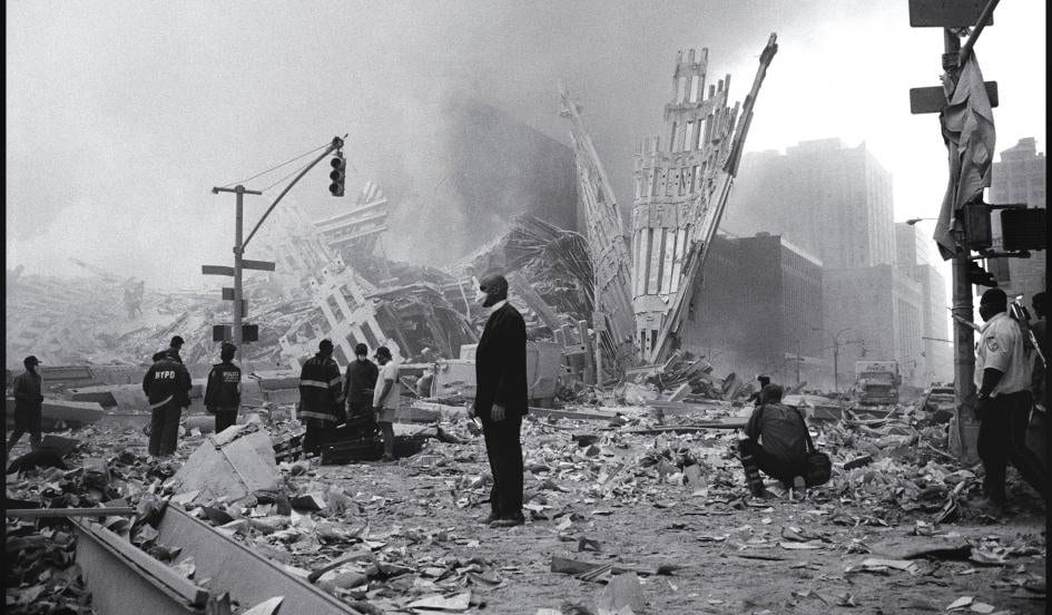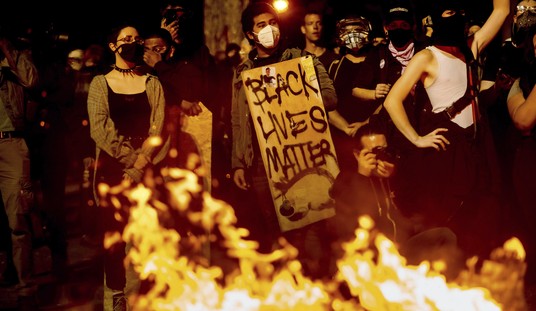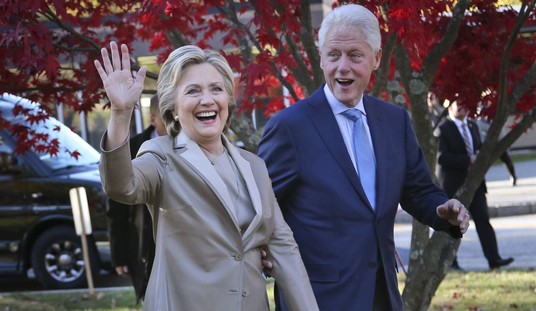As I’ve recounted in more than 30 articles here at PJ Media over the past three years, virtually every Islamic terrorist who has conducted an attack in the West since 9/11 has already been known to authorities, which prompted me to coin the phrase “known wolf” terrorism.
Amidst the commemoration of the 16th anniversary of 9/11, it bears recalling that 9/11 itself was a “known wolf” attack, too.
The CIA had intelligence that two Saudi 9/11 hijackers were living in the United States, but they deliberately refused to share the information with the FBI. The FBI had authority to act on such information and possibly prevent the 9/11 attacks:
— CIA (@CIA) September 11, 2017
In many respects, the 3,000 Americans killed on 9/11 were not only the victims of al-Qaeda terrorists, but also bureaucratic incompetence and inter-governmental turf wars. Who among those who sat on the information were punished? Well, none were.
The CIA sitting on critical intelligence until just days before the attack was couched in the larger excuse of “intelligence failures,” and swept under the rug.
Some of what we know about the CIA’s pre-9/11 intelligence about the hijackers comes from a joint congressional inquiry several years after the attacks. But the most revealing information has come from former FBI agent Mark Rossini, who — though an FBI agent — was assigned to the CIA and prevented from sharing the information with his colleagues.
Two years ago, Jeff Stein at Newsweek detailed Rossini’s story:
Rossini is well placed to do just that. He’s been at the center of one of the enduring mysteries of 9/11: Why the CIA refused to share information with the FBI (or any other agency) about the arrival of at least two well-known Al-Qaeda operatives in the United States in 2000, even though the spy agency had been tracking them closely for years.
That the CIA did block him and Doug Miller, a fellow FBI agent assigned to the “Alec Station,” the cover name for CIA’s Osama bin Laden unit, from notifying bureau headquarters about the terrorists has been told before, most notably in a 2009 Nova documentary on PBS, “The Spy Factory.” Rossini and Miller related how they learned earlier from the CIA that one of the terrorists (and future hijacker), Khalid al-Mihdhar, had multi-entry visas on a Saudi passport to enter the United States. When Miller drafted a report for FBI headquarters, a CIA manager in the top-secret unit told him to hold off. Incredulous, Miller and Rossini had to back down. The station’s rules prohibited them from talking to anyone outside their top-secret group.
The various commissions and internal agency reviews that examined the “intelligence failure” of 9/11 blamed institutional habits and personal rivalries among CIA, FBI and National Security Agency (NSA) officials for preventing them from sharing information. Out of those reviews came the creation of a new directorate of national intelligence, which stripped the CIA of its coordinating authority. But blaming “the system” sidesteps the issue of why one CIA officer in particular, Michael Anne Casey, ordered Rossini’s cohort, Miller, not to alert the FBI about al-Mihdhar. Or why the CIA’s Alec Station bosses failed to alert the FBI—or any other law enforcement agency—about the arrival of Nawaf al-Hazmi, another key Al-Qaeda operative (and future hijacker) the agency had been tracking to and from a terrorist summit in Malaysia.
Because Casey remains undercover at the CIA, Rossini does not name her in his unfinished manuscript. But he wrote, “When I confronted this person…she told me that ‘this was not a matter for the FBI. The next al-Qaeda attack is going to happen in Southeast Asia and their visas for America are just a diversion. You are not to tell the FBI about it. When and if we want the FBI to know about it, we will.’”
Rossini recalled going to Miller’s cubicle right after his conversation with Casey. “He looked at me like I was speaking a foreign language.… We were both stunned and could not understand why the FBI was not going to be told about this.”
It remains a mystery. None of the post-9/11 investigating bodies were able to get to the bottom of it, in part because Rossini and Miller, who continued to work at Alec Station after the attacks, didn’t tell anyone what happened there. When congressional investigators came sniffing around, they kept their mouths shut.
“We were told not to say anything to them,” Rossini said. Who told you that? I asked. “The CIA. I can’t name names. It was just understood in the office that they were not to be trusted, that [the congressional investigators] were trying to pin this on someone, that they were trying to put someone in jail. They said [the investigators] weren’t authorized to know what was going on operationally.… When we were interviewed, the CIA had a person in the room, monitoring us.”
As a result, Rossini wasn’t interviewed by the subsequent 9/11 Commission, either. “Based on that interview, I guess the 9/11 Commission [which followed up the congressional probe] thought I didn’t have anything worthy to say.” He kept his secret, he said, from the Justice Department’s inspector general as well. “I was still in shock,” he added, and still fearful of violating Alec Station’s demand for omerta. Finally, when his own agency—the FBI’s Office of Professional Responsibility (OPR)—came to him in late 2004, after the congressional probe and 9/11 Commission had issued their reports, he opened up.
The CIA has long insisted it shared intelligence about al-Mihdhar and al-Hazmi with the FBI, but records gathered by the 9/11 Commission contradict this assertion. Indeed, the panel could find no records supporting the claim of another Alec Station supervisor, Alfreda Bikowsky, that she had hand-carried a report to the FBI.
“The FBI is telling the truth,” Philip Zelikow, executive director of the 9/11 Commission, told Newsweek. As for why the CIA not only failed to share pre-9/11 information on Al-Qaeda operatives but forbade the FBI agents in Alec Station from sharing it, Zelikow said, “We don’t know.”
Ironically, the intelligence that the CIA was holding onto was from a lead developed by the FBI investigating the bombing of the USS Cole in Yemen.
The FBI had pinpointed an al-Qaeda operative named Ahmed Al-Hada, and from there mapped an extensive network. But the monitoring and intelligence gathering was the purview of the intelligence community, not the FBI.
Lawrence Wright of The New Yorker traced the intelligence the CIA developed on the 9/11 hijackers based on that FBI lead:
A conversation on the Hada phone at the end of 1999 mentioned a forthcoming meeting of Al Qaeda operatives in Malaysia. The C.I.A. learned the name of one participant, Khaled al-Mihdhar, and the first name of another: Nawaf. Both men were Saudi citizens. The C.I.A. did not pass this intelligence to the F.B.I.
However, the C.I.A. did share the information with Saudi authorities, who told the agency that Mihdhar and a man named Nawaf al-Hazmi were members of Al Qaeda. Based on this intelligence, the C.I.A. broke into a hotel room in Dubai where Mihdhar was staying, en route to Malaysia. The operatives photocopied Mihdhar’s passport and faxed it to Alec Station, the C.I.A. unit devoted to tracking bin Laden. Inside the passport was the critical information that Mihdhar had a U.S. visa. The agency did not alert the F.B.I. or the State Department so that Mihdhar’s name could be put on a terror watch list, which would have prevented him from entering the U.S.
The C.I.A. asked Malaysian authorities to provide surveillance of the meeting in Kuala Lumpur, which took place on January 5, 2000, at a condominium overlooking a golf course designed by Jack Nicklaus. The condo was owned by a Malaysian businessman who had ties to Al Qaeda. The pay phone that Soufan had queried the agency about was directly in front of the condo. Khallad used it to place calls to Quso in Yemen. Although the C.I.A. later denied that it knew anything about the phone, the number was recorded in the Malaysians’ surveillance log, which was given to the agency.
At the time of the Kuala Lumpur meeting, Special Branch, the Malaysian secret service, photographed about a dozen Al Qaeda associates outside the condo and visiting nearby Internet cafés. These pictures were turned over to the C.I.A. The meeting was not wiretapped; had it been, the agency might have uncovered the plots that culminated in the bombing of the Cole and the September 11, 2001, attacks. On January 8th, Special Branch notified the C.I.A. that three of the men who had been at the meeting—Mihdhar, Hazmi, and Khallad—were travelling together to Bangkok. There Khallad met with Quso and one of the suicide bombers of the Cole. Quso gave Khallad the thirty-six thousand dollars, which was most likely used to buy tickets to Los Angeles for Mihdhar and Hazmi and provide them with living expenses in the U.S. Both men ended up on planes involved in the September 11th attacks.
In March, the C.I.A. learned that Hazmi had flown to Los Angeles two months earlier, on January 15th. Had the agency checked the flight manifest, it would have noticed that Mihdhar was traveling with him. Once again, the agency neglected to inform the F.B.I. or the State Department that at least one Al Qaeda operative was in the country.
Although the C.I.A. was legally bound to share this kind of information with the bureau, it was protective of sensitive intelligence. The agency sometimes feared that F.B.I. prosecutions resulting from such intelligence might compromise its relationships with foreign services, although there were safeguards to protect confidential information. The C.I.A. was particularly wary of O’Neill, who demanded control of any case that touched on an F.B.I. investigation. Many C.I.A. officials disliked him and feared that he could not be trusted with sensitive intelligence. “O’Neill was duplicitous,” Michael Scheuer, the official who founded Alec Station but has now left the C.I.A., told me. “He had no concerns outside of making the bureau look good.” Several of O’Neill’s subordinates suggested that the C.I.A. hid the information out of personal animosity. “They hated John,” the F.B.I. counterterrorism official assigned to Alec Station told me. “They knew that John would have marched in there and taken control of that case.”
The C.I.A. may also have been protecting an overseas operation and was afraid that the F.B.I. would expose it. Moreover, Mihdhar and Hazmi could have seemed like attractive recruitment possibilities—the C.I.A. was desperate for a source inside Al Qaeda, having failed to penetrate the inner circle or even to place someone in the training camps, even though they were largely open to anyone who showed up. However, once Mihdhar and Hazmi entered the United States they were the province of the F.B.I. The C.I.A. has no legal authority to operate inside the country.
The CIA’s turf war with the FBI, in fact, would cost John O’Neill his life on 9/11. Having retired from the FBI in July 2001, he took up a new position as director of security for the World Trade Center. He died on the job during the attacks.
Other FBI agents working leads related to the 9/11 cell have also expressed frustration at the CIA’s reluctance to share the critical intelligence regarding Mihdhar and Hazmi with the FBI.
The terrorist pair had come under the watch of San Diego FBI agent Steven Butler when they lived there, but the information about their role in the al-Qaeda network was never shared.
Two seasoned New York FBI terror investigators, Frank Pellegrino and John Anticev, also lament that the CIA’s intelligence could have helped prevent the 9/11 attacks.
The view raised by Wright in his New Yorker article that the CIA may have planned to, or possibly unsuccessfully tried to, recruit Mihdhar and Hazmi has the support of at least one senior official.
In a video interview for a documentary, Richard Clarke, who served as counter-terrorism “czar” for President Bill Clinton and President George W. Bush, speculates that this failed CIA recruitment scenario is exactly what happened (particularly ~4:00-8:00):
As Clarke — who was directly involved in a senior role in the events before and after 9/11 — notes, the CIA did finally turn over the information about the presence of Mihdhar and Hazmi in the U.S. three weeks before 9/11 on August 21, but only after they had lost contact with the pair.
Clarke also notes that the information was only shared with lower-level FBI officials and never with senior management.
At a September 4 meeting on terrorism with cabinet-level officials at the White House, the presence of two known al-Qaeda operatives inside the United States was curiously never mentioned, let alone discussed.
One week later, 3,000 Americans would be dead, the World Trade Center would be destroyed, the Pentagon would be heavily damaged, and the U.S. economy would lose $1 trillion in value in just a few days.
As horrific as 9/11 was — the most lethal terrorist attack in modern world history — it is compounded by the tragedy that the reasons why that attack was allowed to happen have STILL never been fully investigated, let alone revealed.
And with each subsequent terror attack in the U.S., we discover that the suspects were again known to law enforcement and intelligence officials — “known wolf” attacks — with all indications that the negligence and mistakes made prior to 9/11 are still being made costing American lives.
That scandal demeans the lives of all those lost on that terrible day.









Join the conversation as a VIP Member